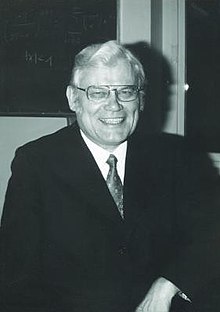Emanuel Sperner
Emanuel Sperner (born December 9, 1905 in Waltdorf (today Prusinowice ) near Neisse , Neisse district ; † January 31, 1980 in Laufen , Markgräflerland) was a German mathematician who is known for two sentences named after him .
Life
He studied first at the Albert Ludwig University of Freiburg , later at the University of Hamburg . There he received his doctorate under Otto Schreier and there he also completed his habilitation. His dissertation of November 5, 1928 is entitled “New evidence for the invariance of the dimensional number and the area”. From 1932 to 1934 he held a visiting professorship in China; This was followed by a professorship at the University of Königsberg from 1934 to 1943 , from 1943 to 1945 at the University of Strasbourg , from 1946 to 1949 at the Albert Ludwig University of Freiburg, from 1949 to 1954 at the University of Bonn and from 1954 to 1974 at the University of Hamburg, where he was Rector from 1963 to 1965 .
He held other visiting professorships and was involved in setting up the Mathematical Research Institute in Oberwolfach . In 1957 he was President of the German Mathematicians Association .
His doctoral students include Gerhard Ringel , Helmut Karzel and Hans-Joachim Arnold .
sentences
Two results from Sperner deserve special mention. Both results are sometimes - with the same name as - especially in the older literature , the Spernersche Lemma (Engl. Sperner's lemma stated).
Sperner's theorem
This theorem states that every anticchain of the power set 2 X of an n -element set X comprises at most M elements, if M is equal to the largest binomial coefficient of order n .
Sperner's Lemma
This lemma , like Sperner's theorem published in 1928 , states that every Sperner coloring of the triangulation of an n-dimensional simplex contains at least one cell which is colored with all colors. Sperner proved that this lemma provides a further proof of a Lebesgue theorem that characterizes the dimension of a Euclidean space. It was later determined that this lemma also provides a direct proof of Brouwer's Fixed Point Theorem, which does not require the explicit use of homologies .
Additional Services
From Sperner's later time, his treatment of ordered geometry with the help of the ordering functions introduced by him should be emphasized.
Furthermore, after Otto Schreier's early death, he published his lectures on analytical geometry and algebra, which for decades served as a basic textbook for mathematical beginners' lectures in linear algebra.
selected Writings
- Collected works , edited by Walter Benz , Lemgo: Heldermann 2005
- with Otto Schreier: Introduction to Analytical Geometry and Algebra , 2 volumes, Teubner 1931, 1935 (Hamburger Mathematische Einzelschriften), Göttingen, Vandenhoeck and Ruprecht (Studia mathematica) 1948, Volume 1 in 7th edition 1969, Volume 2 in 6th edition 1963 (English translation Introduction to modern algebra and matrix theory by Chelsea 1951, Volume 2 as Projective Geometry of n dimensions )
- with Schreier: Lectures on matrices , Hamburg individual mathematical writings, Leipzig, Teubner 1932
- Modern ways of thinking in mathematics: Speech on the occasion of the celebration of the change of Rector at the University of Hamburg on November 12, 1963 , Hamburg University Speeches 1964
- New proof for the invariance of the dimensional number and the area. Abh. Math. Sem. Hamburg VI (1928) 265–272 (dissertation)
- A theorem about subsets of a finite set. Math. Z. 27 (1928) 544-548.
- Via the map of the plane without fixed points. Dep. Math. Se ,. Hamburg X (1934) 1-48.
- To justify the geometry in the delimited section of the plane. Writings of the Königsberg Scholar Society, Math.-Naturw. Class, (Halle ad Saale 1938) 121–143.
- The order functions of a geometry. Math. Annalen 121 (1949) 107-130.
- Relationships between geometrical and algebraic arrangement. Meeting area Heidelberg Akad. D. Knowledge 1949, 10th edition, 3–38.
- Convexity in order functions. Abh. Math. Sem. Hamburg XVI (1949), 140–154.
- A group-theoretical proof of Desargues' theorem in absolute axiomatics. Arch. D. Math. 5: 458-468 (1954).
literature
- W. Benz, H. Karzel, A. Kreuzer (Eds.): Emanuel Sperner Collected Works . Heldermann 2005, ISBN 3-88538-502-3 .
- Konrad Engel: Sperner Theory. ( Memento from January 6, 2013 in the web archive archive.today ) More information on the page
- Egbert Harzheim : Introduction to combinatorial topology (= THE MATHEMATICS. Introduction to the subject matter and results of its sub-areas and related sciences ). Scientific Book Society , Darmstadt 1978, ISBN 3-534-07016-X . MR0533264
Web links
- Literature by and about Emanuel Sperner in the catalog of the German National Library
- Entry in the mathematician family tree
- Emanuel Sperner . Entry in the virtual city tour in Hamburg .
Remarks
- ↑ A Sperner coloring is exemplified by the triangulation of a triangle with the corners A, B, C: 1. Each corner point A, B, C is colored differently. 2. Each point on one side of the triangle A, B, C is colored with a color of the corresponding corner points.
- ↑ see Harzheim 1978
| personal data | |
|---|---|
| SURNAME | Sperner, Emanuel |
| BRIEF DESCRIPTION | German mathematician |
| DATE OF BIRTH | December 9, 1905 |
| PLACE OF BIRTH | Waltdorf near Neisse , Neisse district |
| DATE OF DEATH | January 31, 1980 |
| Place of death | To run |

